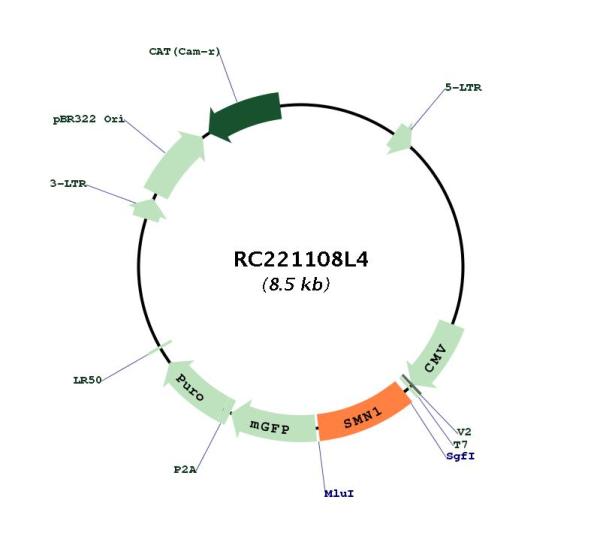SMN1 (NM_022874) Human Tagged Lenti ORF Clone
CAT#: RC221108L4
- LentiORF®
Lenti ORF clone of Human survival of motor neuron 1, telomeric (SMN1), transcript variant b, mGFP tagged
"NM_022874" in other vectors (6)
USD 365.00
Specifications
| Product Data | |
| Type | Human Tagged ORF Clone |
| Tag | mGFP |
| Symbol | SMN1 |
| Synonyms | BCD541; GEMIN1; SMA; SMA1; SMA2; SMA3; SMA4; SMA@; SMN; SMNT; T-BCD541; TDRD16A |
| Vector | pLenti-C-mGFP-P2A-Puro |
| E. coli Selection | Chloramphenicol (34 ug/mL) |
| Mammalian Cell Selection | Puromycin |
| Sequence Data |
The ORF insert of this clone is exactly the same as(RC221108).
|
| Restriction Sites |
SgfI-MluI
Cloning Scheme for this gene
Plasmid Map

|
| ACCN | NM_022874 |
| ORF Size | 786 bp |
| OTI Disclaimer | The molecular sequence of this clone aligns with the gene accession number as a point of reference only. However, individual transcript sequences of the same gene can differ through naturally occurring variations (e.g. polymorphisms), each with its own valid existence. This clone is substantially in agreement with the reference, but a complete review of all prevailing variants is recommended prior to use. More info |
| OTI Annotation | This clone was engineered to express the complete ORF with an expression tag. Expression varies depending on the nature of the gene. |
| Product Components | The ORF clone is ion-exchange column purified and shipped in a 2D barcoded Matrix tube containing 10ug of transfection-ready, dried plasmid DNA (reconstitute with 100 ul of water). |
| Reconstitution | 1. Centrifuge at 5,000xg for 5min. 2. Carefully open the tube and add 100ul of sterile water to dissolve the DNA. 3. Close the tube and incubate for 10 minutes at room temperature. 4. Briefly vortex the tube and then do a quick spin (less than 5000xg) to concentrate the liquid at the bottom. 5. Store the suspended plasmid at -20°C. The DNA is stable for at least one year from date of shipping when stored at -20°C. |
| Reference Data | |
| RefSeq | NM_022874.1 |
| RefSeq Size | 1525 bp |
| RefSeq ORF | 789 bp |
| Locus ID | 6606 |
| UniProt ID | Q16637 |
| Cytogenetics | 5q13.2 |
| Domains | TUDOR |
| Protein Families | Druggable Genome, Stem cell - Pluripotency |
| MW | 28.4 kDa |
| Gene Summary | This gene is part of a 500 kb inverted duplication on chromosome 5q13. This duplicated region contains at least four genes and repetitive elements which make it prone to rearrangements and deletions. The repetitiveness and complexity of the sequence have also caused difficulty in determining the organization of this genomic region. The telomeric and centromeric copies of this gene are nearly identical and encode the same protein. However, mutations in this gene, the telomeric copy, are associated with spinal muscular atrophy; mutations in the centromeric copy do not lead to disease. The centromeric copy may be a modifier of disease caused by mutation in the telomeric copy. The critical sequence difference between the two genes is a single nucleotide in exon 7, which is thought to be an exon splice enhancer. Note that the nine exons of both the telomeric and centromeric copies are designated historically as exon 1, 2a, 2b, and 3-8. It is thought that gene conversion events may involve the two genes, leading to varying copy numbers of each gene. The protein encoded by this gene localizes to both the cytoplasm and the nucleus. Within the nucleus, the protein localizes to subnuclear bodies called gems which are found near coiled bodies containing high concentrations of small ribonucleoproteins (snRNPs). This protein forms heteromeric complexes with proteins such as SIP1 and GEMIN4, and also interacts with several proteins known to be involved in the biogenesis of snRNPs, such as hnRNP U protein and the small nucleolar RNA binding protein. Multiple transcript variants encoding distinct isoforms have been described. [provided by RefSeq, Jul 2014] |
Documents
| Product Manuals |
| FAQs |
| SDS |
Resources
Other Versions
| SKU | Description | Size | Price |
|---|---|---|---|
| RC221108 | SMN1 (Myc-DDK-tagged)-Human survival of motor neuron 1, telomeric (SMN1), transcript variant b |
USD 300.00 |
|
| RC221108L1 | Lenti ORF clone of Human survival of motor neuron 1, telomeric (SMN1), transcript variant b, Myc-DDK-tagged |
USD 600.00 |
|
| RC221108L2 | Lenti ORF clone of Human survival of motor neuron 1, telomeric (SMN1), transcript variant b, mGFP tagged |
USD 600.00 |
|
| RC221108L3 | Lenti ORF clone of Human survival of motor neuron 1, telomeric (SMN1), transcript variant b, Myc-DDK-tagged |
USD 600.00 |
|
| RG221108 | SMN1 (tGFP-tagged) - Human survival of motor neuron 1, telomeric (SMN1), transcript variant b |
USD 500.00 |
|
| SC310587 | SMN1 (untagged)-Human survival of motor neuron 1, telomeric (SMN1), transcript variant b |
USD 300.00 |
{0} Product Review(s)
Be the first one to submit a review






























































































































































































































































 Germany
Germany
 Japan
Japan
 United Kingdom
United Kingdom
 China
China

